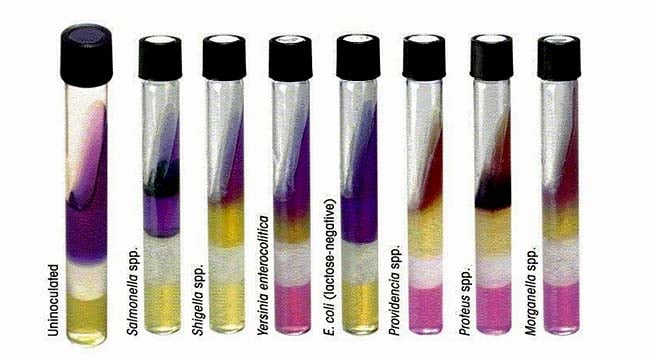Interesting Science Videos
Objective of Lysine Iron Agar Test
To differentiate gram-negative bacilli based on decarboxylation or deamination of lysine and the formation of hydrogen sulfide (H2S).
Principle of Lysine Iron Agar Test
Lysine iron agar (LIA) contains lysine, peptones, a small amount of glucose, ferric ammonium citrate, and sodium thiosulfate. The medium has an aerobic slant and an anaerobic butt. Lysine deamination is an aerobic process that occurs on the slant of the media. Lysine decarboxylation is an anaerobic process that occurs in the butt of the media. The indicator in LIA is bromcresol purple. Bromocresol purple, the pH indicator, is yellow at or below pH 5.2 and purple at or above pH 6.8. When glucose is fermented, the butt of the medium becomes acidic (yellow). If the organism produces lysine decarboxylase, cadaverine is formed. Cadaverine neutralizes the organic acids formed by glucose fermentation, and the butt of the medium reverts to the alkaline state (purple). If the decarboxylase is not produced, the butt remains acidic (yellow). Organisms that deaminate lysine, form alpha – ketocarboxylic acid, which reacts with iron salt near the surface of the medium under the influence of oxygen to form a reddish-brown compound. If deamination does not occur, the LIA slant remains purple. Sodium thiosulfate is incorporated into this medium as the source of hydrogen sulfide and acts as the substrate for enzymatic reduction and the resultant colorless hydrogen sulfide gas reacts with ferric ammonium citrate to produce ferrous sulfide, an insoluble black precipitate that blackens the medium.
Media Used for Lysine Iron Agar Test
| L-Lysine Hydrochloride | 10.0 gm |
| Peptone | 5.0 gm |
| Yeast Extract | 3.0 gm |
| Dextrose | 1.0 gm |
| Ferric Ammonium Citrate | 0.5 gm |
| Sodium Thiosulfate | 0.04 gm |
| Bromcresol Purple | 0.02 gm |
| Agar | 15.0 gm |
Final pH 6.7 +/- 0.2 at 25ºC.
Procedure of Lysine Iron Agar Test
- With a straight inoculating needle, inoculate LIA by stabbing through the center of the medium to the bottom of the tube and then streaking the slant while withdrawing needle.
- Incubate tubes aerobically with loose caps at 35-37ºC for 18-48 hours and examine reaction of medium.
Result Interpretation of Lysine Iron Agar Test

Lysine Decarboxylation (detected in the butt):
Positive Test: Purple slant/purple butt (alkaline), the butt reaction may be masked by H2S production
Negative Test: Purple slant/yellow butt (acid), fermentation of glucose only
Lysine Deamination (detected on a slant):
Positive Test: Red slant
Negative Test: Slant remains purple
H2S Production:
Positive Test: Black precipitate
Negative Test: No black color development
Gas production: demonstrated by the presence of bubbles or cracks in the medium
Limitations
- It is recommended that biochemical, immunological, molecular, or mass spectrometry testing be performed on colonies from pure culture for complete identification.
- It is important to stab the butt of the medium. Failure to stab the butt invalidates this test. The integrity of the agar must be maintained when stabbing. Caps must be loosened during this test or erroneous results will occur.
- LIA is not as sensitive in detecting hydrogen sulfide in comparison to other iron containing mediums, such as Sulfide Indole Motility (SIM) Medium and TSIA. H2S production may not be seen with organisms that do not produce lysine decarboxylase, such as Proteus spp., since acid in the butt may suppress H2S formation.
- Certain species or strains may give delayed reactions or completely fail to ferment the carbohydrate in the stated manner. However, in most cases if the organism fails to ferment dextrose within 48 hours, and growth is definitely present, the organism is most likely not in the Enterobacteriaceae family.
- Slant reaction with Morganella morganii may be variable after 24 hours incubation and may require longer incubation.
- Gas production may be irregular or suppressed with organisms other than Citrobacter spp.
- Salmonella enterica serovar Paratyphi A does not produce lysine decarboxylase.
Quality Control
Purple slant and yellow butt: H2S positive: Citrobacter freundii (ATCC8090)
Purple slant and butt, H2S negative: Escherichia coli (ATCC25922)
Purple slant and butt, H2S positive: Salmonella Typhimurium (ATCC14028)
Red slant and yellow butt, H2S negative: Proteus mirabilis (ATCC12453)

More micronotes and biochemical rxn